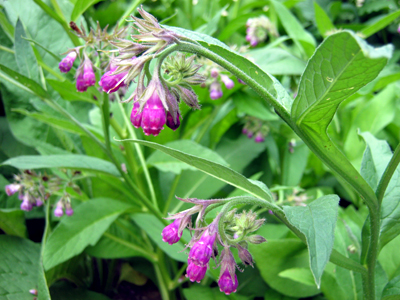 |
Symphytum
Comfrey
Symphytum
Comfrey is in the plant family Boraginaceae in the genus Symphytum.
The word ‘Symphytum’ is Latin and comes from the Greek ‘symphis’ and ‘symphyo’ which mean ‘growing together’ and from ‘phyton’ which mean plant.
|
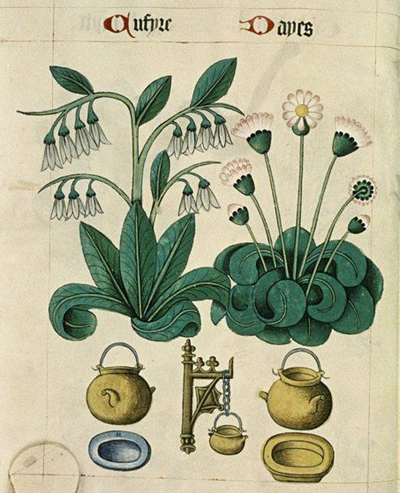 |
Early
Words for Comfrey
The Word “Comfrey”
In the middle ages (1275-1325) the word used for comfrey in Middle English was ‘cumfirie’ and ‘conferye’. In Anglo-French the word was ‘cumfirie’. In Old French it was ‘confire’. Those words come from the Latin words ‘conferva’ and ‘confervere’.
‘Conferva’ (confervae) is a feminine, singular noun. It means a freshwater (aquatic) plant with medicinal power. The word appears in Pliny’s “Natural History” (Naturalis Historia), a 77 AD encyclopedia written in Latin by Pliny the Elder, a Roman author and naval commander.
‘Confervere’ (confervo) is an intrasitive verb in the third conjugation. It mean to knit broken bones, to grow together, to heal seethe/boil together. From the “Oxford Latin Dictionary”, 1982.
This drawing is from 'The Tudor Pattern Book' circa 1520-1530 AD. The image on the left is comfrey, on the right is daisy.
|
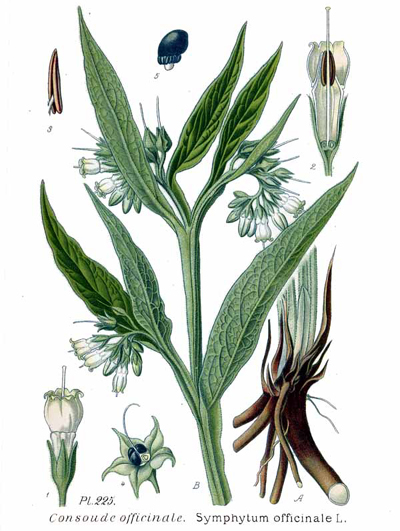 |
Symphytum
officinale
Today the comfrey plants you are most likely to find are Symphytum officinale and Symphytum uplandicum or Symphytum uplandica.
‘Officinale’ means it was the official medicinal plant sold in apothecaries and pharmacopoeias in the middle ages (5th- 15th centuries AD).
‘Officinalis’ or ‘officinale’ are Medieval Latin words that mean a plant was (is) used in medicine and herbalism. The word frequently occurs as the second term of a two-part botanical name.
|

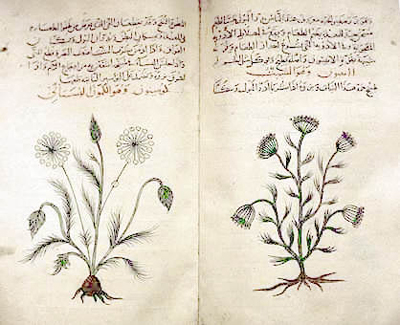
|
Ancient
Greeks and Comfrey
Since 400 BC comfrey root was used in Greece. The Greek historian Herodotus (484- 425 BC) recommended it to stop severe bleeding. Later Greeks used it to heal bronchial (lung) problems.
In the second century the Greek poet/physician, Nicander of Colophon, wrote about comfrey in his herbal book ‘Alexipharmaca’.
The Greek physician Pedanius Dioscorides (40- 90 AD) recommended it for healing wounds, repairing broken bones, and curing lung/stomach problems. He authored ‘De Materia Medica’ (On Medical Materials), a 5-volume Greek encyclopedia about herbs and medicinal substances, 65 AD. This pharmacopeia was used for 1,500 years. It is the most influential and important herbal ever written.
Dioscorides (a Greek) worked for the Roman army as a surgeon. He had to
help heal trauma injuries, so he was particularly interested in herbs that
stopped bleeding such as yarrow, and in wound repair herbs such as comfrey
and calendula.
Galen of Pergamon, a famous Greek physician and philosopher (130- 200 AD),
included comfrey in his medical treatises such as ‘Galenou Apanta’.
The first photo is Herodotus. The second photo is 'De Materica Medica' by
Dioscorides translated into Arabic.
|
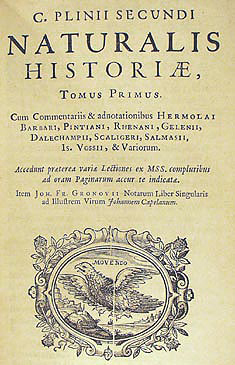

|
Romans and Comfrey
Pliny the Elder (23-79 AD), a Roman naturalist and philosopher used comfrey root medicinally.
He wrote: “The roots be so glutinative that they will solder or glew together meat that is chopt in pieces, seething in a pot, and make into one lump.” Pliny found comfrey root to be good as a poultice for binding broken bones together.
Pliny wrote 15 books on medicinal plants including ‘Naturalis Historia’
(Of Natural History) (77–79 BC). It is one of the largest single works (37 volumes) to have survived from the Roman Empire, a great book of ancient knowledge.
"Pliny experimented and documented many uses and the preparation of comfrey
for both internal and external use as well as its adhesive qualities. Preparation
of the remedy for internal use involved taking the root of the plant and
crushing it and mixing it with water or decoction, which is a method of
extracting oils by boiling; this would then be taken with wine. A final
faster method for respiratory ailments would be to chew the root. They used
these remedies for the internal treatment of kidney disease, stomach and
intestinal cramps, diarrhoea and lung disease such as lung bleeding. It
was used to treat sprains, contusions, fractured bones and aid wound healing."
The above quote is from Eve Maria Thoresen, Faculty of Veterinary Science,
Szent Istvan University, Department of Botany, Budapest Hungary, 2013, Symphytum
officinale, Common Comfrey (Source: Pliny the Elder - Naturalis Historia,
AD 79: Book 27 Chapter 24.)
The
first photo is 'Naturalis Historia' by Pliny. The second photo is the Roman
Pliny.
|
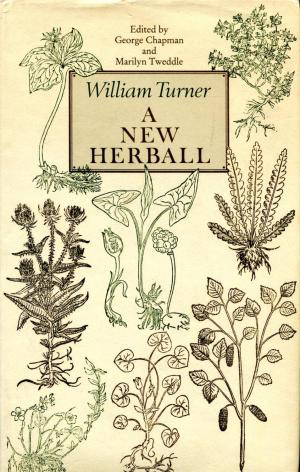 |
Early Renaissance (15th- 16th Centuries)
Swiss physician Paracelsus (1493-1541 AD) said: “To what purpose do you superadde vinegar to the root of Comfrey or bole, or suchlike balefull additaments, while God hath compos'd this simple sufficient to cure the fracture of the bones?”
From ‘A New Herball’ by William Turner (1568): "of Comfrey Symphytum, the rootes are good if they be broken and dronken for them that spitte blood, and are bursten. The same, layd to, are good to glewe together freshe woundes. They are good to be layd to inflammation."
|
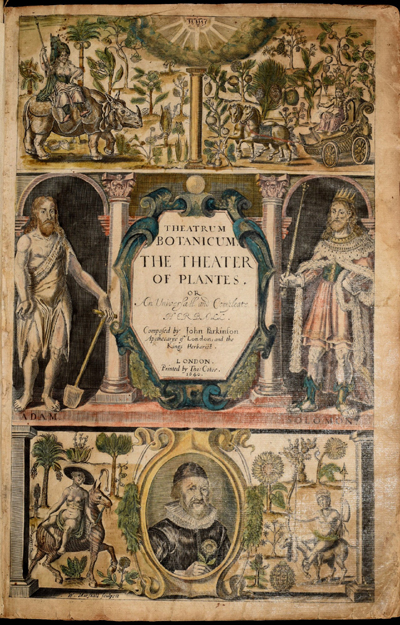
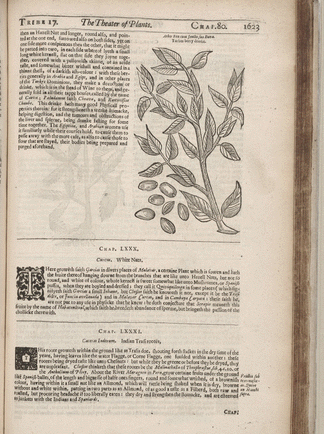
 |
Renaissance (17th Century)
John Parkinson (1567-1650) was a Master Herbalist and apothecary to King James I. In his book ‘Theatrum Botanicum: Theater of Plants Or An Herball of Large Extent’ (1640): "The rootes of Comfrey, taken fresh, beaten small, spread upon leather, and laid upon any place troubled with the gout, doe presently give ease of the paines and applied in the same manner, giveth ease to pained joynts, and profiteth very much for running and moist ulcers, gangrenes, mortifications and the like."
English herbalist, botanist, physician Nicholas Culpeper (1616-1654) wrote in ‘Complete Herbal’ (1653) about comfrey roots: “full of glutinous and clammy juice...for all inward hurts...and for outward wounds and sores in fleshy or sinewy parts of the body...It is especially good for ruptures and broken bones.” He mentioned comfrey for fever, gangrene, gout, hemorrhoids, and respiratory ailments.
The first and second photos are 'The Theater of Plants'. The third photo is John Parkinson.
|
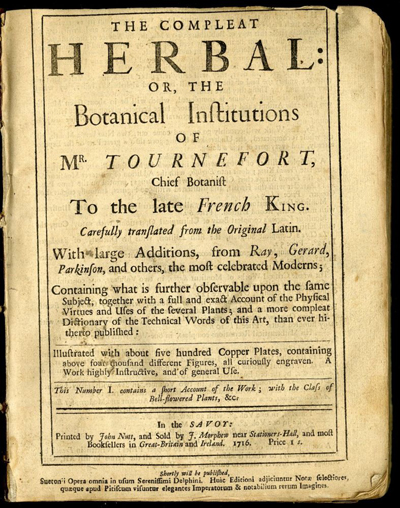
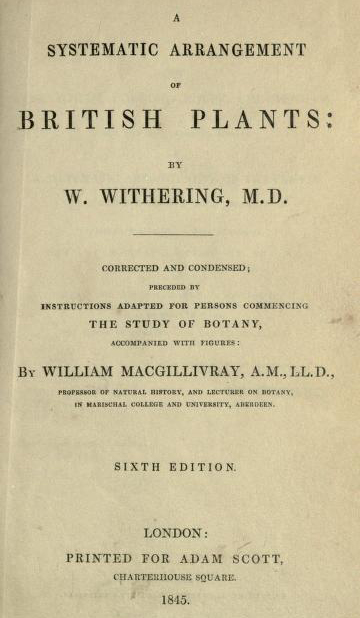 |
Age of Enlightenment (18th Century)
Tournefort's ‘Compleat Herbal Or The Botanical Institutions’ (1719) gives a long account of the characteristics and "vertues" (virtues) of comfrey.
Tournefort wrote: "cured a certain person of a malignant ulcer, pronounced to be a cancer by the surgeons, and left by them as incurable, by applying twice a day the root of comfrey bruised, having first peeled off the external blackish bark or rind; but the cancer was not above eight or ten weeks standing."
In 1787 English physician Dr. William Withering (1741-1799), and in 1845 naturalist William MacGillivray (1796-1852) wrote about Comfrey in “A Systematic Arrangement of British Plants”.
|
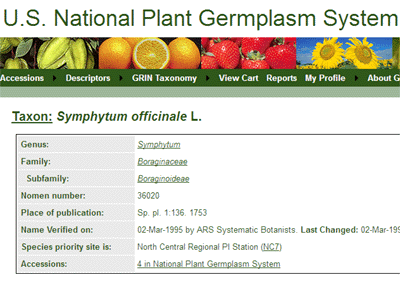 |
References: Government & Databases
United States Department of Agriculture, Agricultural Research Service, US National Plant Germplasm System, Taxons:
Symphytum asperum Lepech: https://npgsweb.ars-grin.gov/gringlobal/taxonomydetail.aspx?36019
Symphytum officinale L.: https://npgsweb.ars-grin.gov/gringlobal/taxonomydetail.aspx?36020
Global Biodiversity Information Facility, Symphytum L: http://www.gbif.org/species/101333557
Dr Duke’s Phytochemical and Ethnobotanical Databases.
Symphytum Officinale:
https://phytochem.nal.usda.gov/phytochem/plants /show/1926?qlookup=comfrey&offset
|
 |
References:
Ancient, Renaissance & Enlightenment Herbals (Before 1900)
A New Herbal: Wherin Are Conteyned the Names of Herbes by William Turner. Part I (1551), Part II (1562) and Part III (1568).
A Systematic Arrangement of British Plants by Dr William Withering and William MacGillivray, 1787 and 1845.
Compleat Herbal by Tournefort, 1719.
Culpeper’s Complete Herbal by Nicolas Culpeper, 1653.
De Materia Medica by Pedanius Dioscorides, 65 AD.
Lancet: Another New Cancer Cure by Professor William Thompson, 1896.
Theatrum Botanicum: Theater of Plants Or An Herball of Large Extent by John Parkinson, 1640.
This artwork is Dioscorides who wrote 'De Materica Medica'.
|
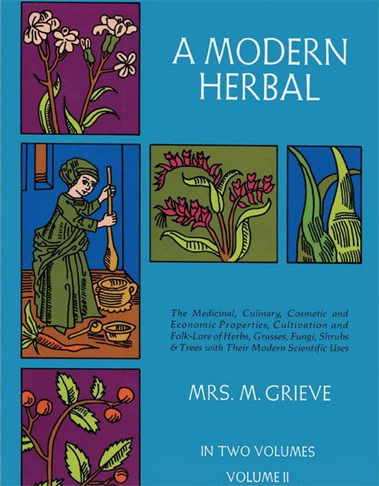
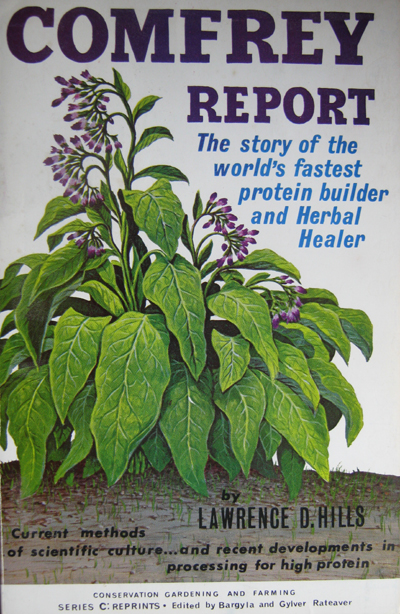
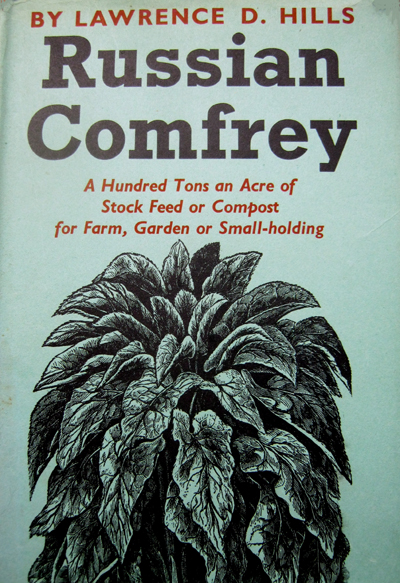 |
References: Modern Herbals
A Modern Herbal: Medicinal, Culinary, Cosmetic and Economic Properties,
Cultivation and Folk-Lore of Herbs by Mrs. Maud Grieve. New York: Dover
Publications, 1971. First published in 1931.
Alternative Field Crops Manual, University of Wisconsin-Extension, Cooperative Extension: Comfrey: https://www.hort.purdue.edu/newcrop/afcm/comfrey.html
Botany in a Day: The Patterns Method of Plant Identification by Thomas J Elpel. Montana: Hops Press LLC, 2004.
Comfrey: An Ancient Medicinal Remedy by Charles J. MacAlister. England: Read Books Ltd, Lowrie Press, 2012.
Comfrey: Fodder, Food and Remedy by Lawrence D Hills, 1976. New York: Rizzoli Universe Books: 1976.
Comfrey Report: The Story of the World's Fastest Protein Builder and Herbal Healer by Lawrence D Hills. England: Conservation Gardening and Farming Series: Series C, 1975.
Cunningham's Encyclopedia of Magical Herbs by S Cunningham. Woodbury: Llewellyn Publications, 2000.
Edible Forest Gardens by Dave Jacke and Eric Toensmeier. Chelsea Green, 2005.
Green Pharmacy by Barbara Griggs. Rochester, Vermont: Healing Arts Press, 1997.
Herbal Renaissance by S Foster. Utah: Peregine Smith Books, 1984.
Herbal Healing for Woman by Rosemary Gladstar. New York: Fireside Publishing, 1993.
The Herbal Medicine-Maker's Handbook: A Home Manual by J Green. Random House LLC, 2011.
Herbal Preparations and Natural Therapies: Creating and Using a Home Herbal Medicine Chest by Debra St.Claire. Colorado: Morningstar Publications, 1994.
Nutritional Herbology: A Reference Guide to Herbs by Mark Pederson. Indiana: Wendell W. Whitman Co., 1995.
Principles and Practice of Phytotherapy: Modern Herbal Medicine by S Mills and K Bone. Edinburgh: Churchill Livingstone, 2000.
Russian Comfrey: A Hundred Tons an Acre of Stock or Compost for Farm, Garden or Smallholding by Lawrence D Hills. England: Henry Doubleday, 1953.
School of Natural Healing: Herbal Reference Guide by John R. Christopher. Colorado: Nutri Books Corp: 1996.
Therapeutic Herb Manual by Ed Smith. Oregon: Ed Smith, 2003.
The Way of Herbs by Michael Tierra, C.A., N.D. New York: Simon & Schuster, 1990.
Western Medicinal Plants and Herbs by Steven Foster and Christopher Hobbs. New York: Houghton Mifflin Co., 2002.
|
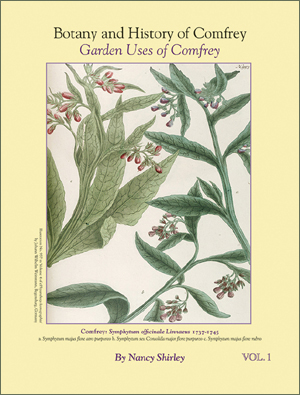 |
Botany
and History of Comfrey
Taxonomy
and Nomenclature of Comfrey
Borage Family, Symphytum Genus
Symphytum Species
Symphytum Species Classifications
Symphytum Genus Description
Symphytum Species Overview
Details about Symphytum Species
Details about Symphytum Species Hybrids
Comfrey
Book, Vol 1: Botany of Comfrey- page 1 pdf
Prehistory, Ancient Times, Middle Ages and Comfrey
Renaissance and Comfrey: 1400s to 1600s
Age of Enlightenment and Comfrey: 1700s
Age of Revolution and Comfrey: 1800s
The 1900s and Comfrey
Comfrey
Book, Vol 1: History of Comfrey- page 1 pdf
|
|















